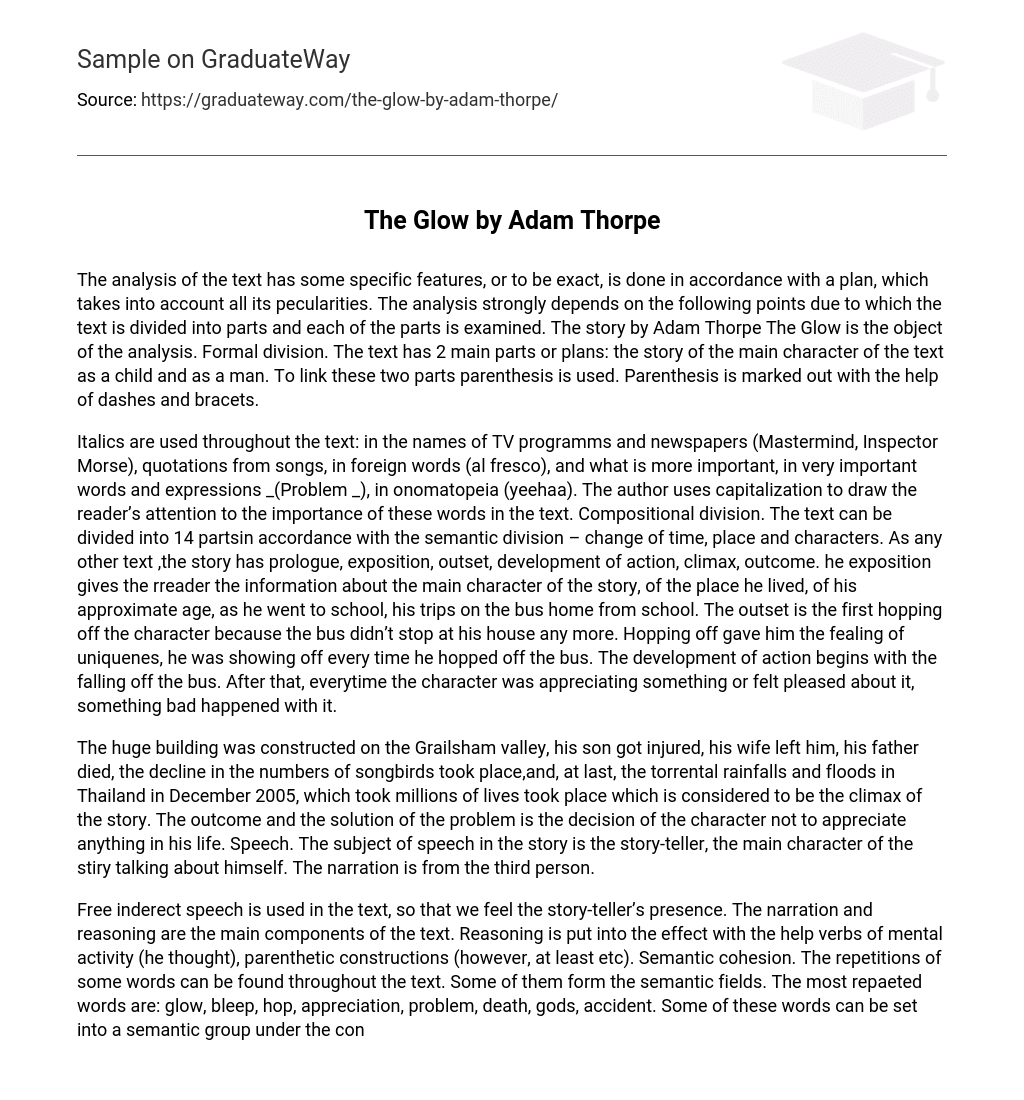The analysis of the text has specific features that are carried out according to a plan. This plan considers all the peculiarities of the text. The analysis relies heavily on several key points which involve dividing the text into parts and examining each part individually. The focus of the analysis is Adam Thorpe’s story “The Glow”. The text is divided into two main parts or plans: the story of the main character as a child and as an adult. These two parts are connected by the use of parenthesis, marked by dashes and brackets.
The text includes the use of italics in various instances: TV program and newspaper names (Mastermind, Inspector Morse), song quotes, foreign words (al fresco), important words and expressions (Problem), and onomatopoeia (yeehaa). The author also utilizes capitalization to emphasize the significance of these words. The text can be divided into 14 parts based on changes in time, location, and characters. Similar to any other text, it follows a structure consisting of a prologue, exposition, outset, action development, climax, and outcome. The exposition provides information about the main character, their place of residence, approximate age, schooling, and bus trips home. The outset marks the character’s first significant departure from the bus due to it no longer stopping at their house. Hopping off made the character feel unique and they would show off each time they did so. The development of action starts with the character falling off the bus. Thereafter, whenever they appreciated something or felt pleased about it, something negative would occur.
The massive construction occurred at the Grailsham valley, resulting in his son’s injury and his wife leaving him. Additionally, his father passed away, the songbird population declined, and ultimately, the devastating rainfalls and floods in Thailand in December 2005, claiming numerous lives, marked the story’s climax. The character’s resolution to not value anything in his life serves as the outcome and solution to the problem. The speech focuses on the story-teller, who is also the main character, discussing himself. The narration adopts a third-person perspective.
The text employs free indirect speech to convey the presence of the story-teller. It primarily consists of narration and reasoning, which is emphasized through the use of mental activity verbs (such as “he thought”) and parenthetic constructions (such as “however” and “at least”). Semantic cohesion can be observed through the repetition of certain words, some of which form semantic fields. The most frequently repeated words include glow, bleep, hop, appreciation, problem, death, gods, and accident. A subgroup within these words can be identified under the concept of destruction.
The term “bleepers” is prominently used in the text, initially in reference to the sound of medical equipment in the hospital. This connection symbolizes the metaphorical “bleepers” of the gods, serving as a signal of impending danger. The text also includes frequent repetitions of certain phrases, particularly lines from songs. It demonstrates grammatical cohesion by beginning with the Past Perfect tense, transitioning to the Past Simple tense, and ultimately concluding with the Future in the Past tense – conveying a possible future yet to be realized, as the storyteller expresses confidence in their decision-making abilities.
Pragmatic cohesion is demonstrated through the metaphorical usage of the term “bleepers,” initially associated with the sounds of medical equipment and later connected to metaphoric bleepers of god. Moreover, the presence of other recurring words contributes to the establishment of a system of metaphors. Intertextually, the text makes references to band names, song lines (“Love, love me do, I’ll always be true”), college and street names (Broad Hill Farm, Tech College, Princedale Avenue), TV programs and channels (Masterminds, BBC, Inspector Morse), as well as newspapers (Telegraph).





